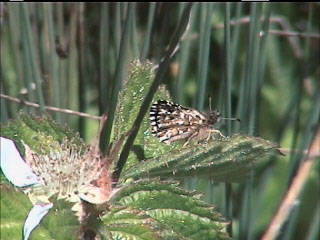The Laguna Mountain Skipper

Photo by Dave Powell. It's the non-endangered subspecies.
One of my favorite places in the world is the mountainous area juste east of San Diego. It's am incredible jumble of ecosystem types: mountain chaparral, pine woodlands, and desert. It's one of the few places I know of where, while hiking through a very dry desert, you can look up to the hills just west of you and see pine trees cresting the ridgeline. It's the home to a number of endangered species of butterflies, including the Laguna Mountain Skipper. This subspecies of the two-banded skipper appears to have dwindled to a precariously few populations. Habitat destruction is, as usual, the source of the decline of this species. The problem is a bit more interconnected than just that however. Caterpillars of this butterfly feed only on one species of plant: Horkelia clevelandii.

This species of horkelia is itself declining substantially, becasue of pressures like development, cattle grazing, and trampling. The butterfly that is depending on it is, for better or for worse, along for the ride. The Fish and Wildlife Service has recently begun stepping up efforts to protect the butterfly. A meeting next month will presage the assempbly of a species recovery team. I've been invited to the meeting to discuss pcaptive breeding, molecular genetic management, and monitoring. The upshot is that I will have to leave Chicago and fly to San Diego at the end of February. Such is my lot in life. As pleasant as the travel will be, the real exciting part for me is that I will have the opportunity to participate in the conservation of another species of seriously endangered butterfly.
Labels: Butterflies, Endangered Species


2 Comments:
and another wild and crazy trip to boot
It's fabulous that you're helping in conversation as you do. My niece has been working in saving endangered plants at several spots on the globe and now LIVES about an hour from the area you'll be at. I grew up near the Steens Mountain in SE Oregon that is exactly the desert you describe...arid dry and as you look up...the tops of the Steens are an alpine forest with year round snow caps. It's gorgeous. Thanks for a great post as usual.
Post a Comment
<< Home